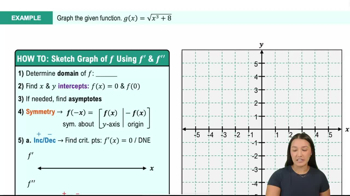Table of contents
- 0. Functions7h 52m
- Introduction to Functions16m
- Piecewise Functions10m
- Properties of Functions9m
- Common Functions1h 8m
- Transformations5m
- Combining Functions27m
- Exponent rules32m
- Exponential Functions28m
- Logarithmic Functions24m
- Properties of Logarithms34m
- Exponential & Logarithmic Equations35m
- Introduction to Trigonometric Functions38m
- Graphs of Trigonometric Functions44m
- Trigonometric Identities47m
- Inverse Trigonometric Functions48m
- 1. Limits and Continuity2h 2m
- 2. Intro to Derivatives1h 33m
- 3. Techniques of Differentiation3h 18m
- 4. Applications of Derivatives2h 38m
- 5. Graphical Applications of Derivatives6h 2m
- 6. Derivatives of Inverse, Exponential, & Logarithmic Functions2h 37m
- 7. Antiderivatives & Indefinite Integrals1h 26m
- 8. Definite Integrals4h 44m
- 9. Graphical Applications of Integrals2h 27m
- 10. Physics Applications of Integrals 2h 22m
5. Graphical Applications of Derivatives
Curve Sketching
Problem 3.6.54a
Textbook Question
{Use of Tech} Fuel economy Suppose you own a fuel-efficient hybrid automobile with a monitor on the dashboard that displays the mileage and gas consumption. The number of miles you can drive with g gallons of gas remaining in the tank on a particular stretch of highway is given by m(g) = 50g−25.8g²+12.5g³−1.6g⁴, for 0≤g≤4.
a. Graph and interpret the mileage function.
 Verified step by step guidance
Verified step by step guidance1
To graph the mileage function m(g) = 50g - 25.8g^2 + 12.5g^3 - 1.6g^4, first identify the domain of the function, which is 0 ≤ g ≤ 4. This means we will only consider values of g within this interval.
Next, calculate key points of the function within the domain. This includes finding the value of m(g) at the endpoints g = 0 and g = 4, as well as any critical points where the derivative m'(g) = 0, which will help identify local maxima or minima.
To find the critical points, take the derivative of m(g) with respect to g: m'(g) = 50 - 51.6g + 37.5g^2 - 6.4g^3. Set m'(g) = 0 and solve for g to find the critical points within the interval [0, 4].
Evaluate the function m(g) at the critical points and endpoints to determine the behavior of the function. This will help in understanding how the mileage changes as the amount of gas changes.
Plot the calculated points and sketch the graph of m(g) over the interval [0, 4]. Interpret the graph by analyzing how the mileage varies with the amount of gas, noting any points where the mileage is maximized or minimized.
 Verified video answer for a similar problem:
Verified video answer for a similar problem:This video solution was recommended by our tutors as helpful for the problem above
Video duration:
2mPlay a video:
Was this helpful?
Key Concepts
Here are the essential concepts you must grasp in order to answer the question correctly.
Function Analysis
Function analysis involves studying the properties and behaviors of mathematical functions. In this context, understanding the mileage function m(g) is crucial, as it describes how mileage varies with the amount of gas g. Analyzing this function includes determining its domain, range, and key features such as intercepts and turning points.
Recommended video:

Derivatives Applied To Velocity
Graphing Techniques
Graphing techniques are essential for visually representing mathematical functions. For the mileage function m(g), creating a graph allows for the interpretation of how mileage changes with varying gas levels. This includes plotting points, identifying the shape of the graph, and recognizing trends such as increases or decreases in mileage.
Recommended video:

Graphing The Derivative
Critical Points and Interpretation
Critical points are values of g where the function's derivative is zero or undefined, indicating potential maxima, minima, or points of inflection. In the context of the mileage function, finding these points helps in understanding the optimal gas levels for maximum mileage. Interpreting these points provides insights into fuel efficiency and driving strategies.
Recommended video:

Critical Points

 11:41m
11:41mWatch next
Master Summary of Curve Sketching with a bite sized video explanation from Callie
Start learning




